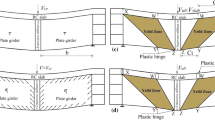Abstract
In steel-concrete composite twin-girder decks, wide concrete slab would undergo significant shear lag warping effect, including positive and negative. Some researchers have investigated the positive shear lag of composite decks by means of one-dimensional line model, while the studies on the negative shear lag have not yet been reported until now. In this study, a new one-dimensional analytical model of composite twin-girder decks is first proposed based on the model proposed by Dezi et al. Besides slab shear lag effect and partial connection at slab-girder interface which have been included in the model of Dezi et al., the particularity of the proposed model relies on its ability to account for variation characteristic of cross-section. Verification of the analytical model is later conducted through comparison of results from the analytical analysis and elaborate FE analysis for a simply supported composite deck with increasing depth and a two-span continuous one with decreasing depth. Finally, three kinds of structural forms of composite twin-girder decks, including cantilever, simply supported and continuous decks, are selected to carry out the analysis of positive and negative shear lag behaviors by means of the analytical model. The influences of cross-sectional variation characteristic and load type on positive and negative shear lag behaviors are mainly investigated. Additionally, a new definition on effective width for considering simultaneously positive and negative shear lag behaviors is proposed. The results from the proposed analytical model and EC4 specification are compared to provide suggestions for designers and checkers. In this study, the proposed analytical model can provide a powerful numerical tool for researchers to conduct the further investigation, and the analysis on shear lag and effective width can assist in design analysis of composite twin-girder decks.
Similar content being viewed by others
References
Reissner E. Analysis of shear lag in box beams by the principle of the minimum potential energy. Q Appl Math, 1946, 4: 268–278
Adekola A O. The dependence of the shear-lag on partial interaction in composite beams. Int J Solids Struct, 1974, 10: 389–400
Newmark N M, Siess C P, Viest I M. Test and analysis of composite beams with incomplete interaction. Proc Soc Exp Stress Anal, 1951, 9: 75–92
Dezi L, Gara F, Leoni G, et al. Time dependent analysis of shear-lag effect in composite beams. J Mech Eng ASCE, 2001, 127: 71–79
Dezi L, Gara F, Leoni G. Shear-lag effect in twin-girder composite decks. J Steel Compos Struct, 2003, 3: 111–122
Sun F F, Bursi O. Displacement-based and two-field mixed variational formulation for composite beams with shear lag. J Mech Eng ASCE, 2005, 131: 199–210
Dezi L, Gara F, Leoni G. Effective slab width in prestressed twingirder composite decks. J Struct Eng ASCE, 2006, 132: 1358–1370
Gara F, Ranzi G, Leoni G. Analysis of the shear lag effect in composite bridges with complex static schemes by means of a deck finite element. Int J Steel Struct, 2008, 8: 249–260
Gara F, Leoni G, Dezi L. A beam finite element including shear lag effect for the time-dependent analysis of steel-concrete composite decks. Eng Struct, 2009, 31: 1888–1902
Gara F, Ranzi G, Leoni G. Short-and long-term analytical solutions for composite beams with partial interaction and shear-lag effects. Int J Steel Struct, 2010, 10: 359–372
Foutch D A, Chang P C. A shear lag anomaly. J Struct Eng ASCE, 1982, 108: 1653–1658
Chang S T, Fang Z Z. Negative shear lag in cantilever box girder with constant depth. J Struct Eng ASCE, 1987, 113: 20–35
Kristek V, Studnicka J. Discussion of “negative shear lag in cantilever box girder with constant depth”. J Struct Eng ASCE, 1988, 114: 2168–2173
Chang S T, Ding Y. Shear lag effect in box girder with varying depth. J Struct Eng ASCE, 1988, 114: 2280–2292
Shushkewich K W. Negative shear lag explained. J Struct Eng ASCE, 1991, 117: 3543–3546
Luo Q Z, Tang J, Li Q S. Negative shear lag effect in box girders with varying depth. J Struct Eng ASCE, 2001, 127: 1236–1239
Luo Q Z, Li Q S, Tang J. Shear lag in box girder bridges. J Bridg Eng ASCE, 2002, 7: 308–313
Lee S C, Yoo C H, Yoon D Y. Analysis of shear lag anomaly in box girders. J Struct Eng ASCE, 2002, 128: 1379–1386
Author information
Authors and Affiliations
Corresponding author
Rights and permissions
About this article
Cite this article
Zhu, L., Nie, J. & Ji, W. Positive and negative shear lag behaviors of composite twin-girder decks with varying cross-section. Sci. China Technol. Sci. 60, 116–132 (2017). https://doi.org/10.1007/s11431-016-0314-x
Received:
Accepted:
Published:
Issue Date:
DOI: https://doi.org/10.1007/s11431-016-0314-x




